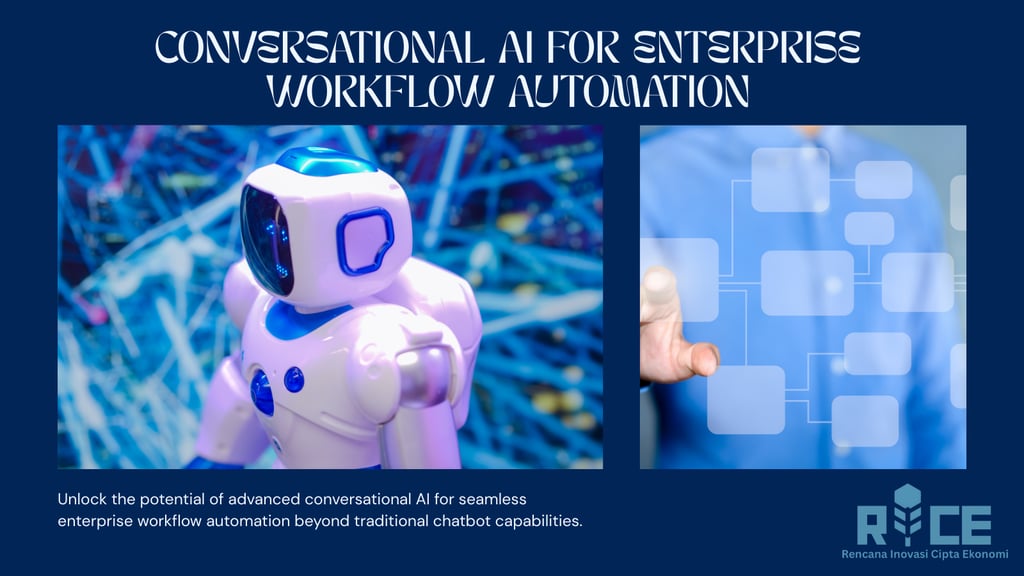Conversational AI for Enterprise Workflow Automation: Beyond Chatbots
Dive deep into how Conversational AI is evolving beyond simple chatbots to become a powerful force for enterprise workflow automation. This article highlight the technologies, challenges, and strategic imperatives for businesses.
TECHNOLOGY
Rice AI (Ratna)
5/23/20258 min read


The modern enterprise is a symphony of interconnected workflows, from customer service and human resources to supply chain management and IT operations. For decades, the pursuit of efficiency has driven digital transformation, automating repetitive tasks and streamlining processes. Yet, a new frontier is emerging, promising to infuse these workflows with intelligence, intuition, and a truly human-centric interaction model: Conversational AI. This isn't merely about chatbots answering FAQs; it's about embedding intelligent conversational interfaces directly into the fabric of business operations, fundamentally reshaping how employees and customers interact with systems and data. This article delves deep into the transformative potential of Conversational AI for enterprise workflow automation, exploring its evolution, applications, challenges, and the strategic imperatives for organizations looking to unlock unparalleled efficiency and a superior user experience.
The Evolution: From Rule-Based Bots to Intelligent Automation Partners
The journey of Conversational AI in the enterprise began humbly with rule-based chatbots. These early iterations, while useful for simple, predictable queries, often frustrated users with their inability to understand nuance or deviate from predefined scripts. Their automation capabilities were limited to routing requests or providing templated responses.
The advent of Artificial Intelligence, particularly advancements in Natural Language Processing (NLP), Natural Language Understanding (NLU), and machine learning, revolutionized this landscape. Modern Conversational AI systems can now:
Understand intent and context: Moving beyond keywords to grasp the underlying meaning of a user's request, even with colloquialisms or incomplete sentences (Gartner, 2023).
Engage in multi-turn dialogues: Maintaining context across several exchanges, mimicking natural human conversation.
Integrate with backend systems: This is the crucial leap, allowing them to not just answer questions, but to execute tasks within enterprise applications like ERP, CRM, HRIS, and IT service management platforms (Forrester, 2024).
Learn and adapt: Continuously improving their understanding and performance through interactions and data analysis.
This evolution signifies a shift from reactive, narrowly-focused "chatbots" to proactive, intelligent "conversational agents" or "AI assistants" that can automate complex, end-to-end workflows.
Automating Beyond the Chat Window: Core Applications in Enterprise Workflows
The true power of Conversational AI lies in its ability to automate workflows across various enterprise functions, extending far beyond traditional customer service.
1. Human Resources (HR) Automation
Conversational AI can transform HR operations, providing immediate support to employees and automating routine tasks, freeing up HR professionals for more strategic initiatives.
Onboarding and Offboarding: Guiding new hires through paperwork, policy explanations, and system access setup; assisting departing employees with exit procedures, benefits information, and final pay details.
Employee Self-Service: Answering queries about company policies, leave requests, benefits enrollment, payroll discrepancies, and training programs.
Internal IT Support: Automatically resetting passwords, troubleshooting common software issues, granting access to applications, and escalating complex problems to human agents. A global financial services firm deployed an internal Conversational AI agent that automated over 60% of common HR and IT queries, reducing resolution times from hours to minutes and significantly improving employee satisfaction (IBM, 2023).
2. Customer Service and Experience (CX) Enhancement
While chatbots are common here, advanced Conversational AI goes further, providing proactive, personalized, and efficient customer interactions.
Personalized Support: Resolving complex customer issues by accessing real-time data from CRM systems, processing returns, managing subscriptions, or providing tailored product recommendations.
Proactive Engagement: Reaching out to customers with updates on orders, service disruptions, or personalized offers, reducing inbound queries.
Omnichannel Consistency: Ensuring a seamless experience across web chat, mobile apps, voice assistants, and social media platforms. A major telecommunications provider integrated Conversational AI with their CRM to handle over 70% of routine customer inquiries, resulting in a 20% reduction in call center volume and a notable increase in customer satisfaction scores (Genesys, 2023).
3. IT Operations and Service Management (ITSM)
Conversational AI can drastically improve the efficiency and responsiveness of IT departments.
Automated Ticket Resolution: Diagnosing and resolving common IT issues, escalating only unique or complex problems.
Incident Management: Assisting with incident reporting, status updates, and basic troubleshooting, reducing Mean Time To Resolution (MTTR).
Resource Provisioning: Automating requests for software licenses, virtual machines, or access to specific networks, based on user roles and permissions. For instance, a large technology company implemented Conversational AI to automate incident reporting and resolution for internal IT issues, leading to a 30% reduction in IT support tickets and faster service delivery (ServiceNow, 2024).
4. Sales and Marketing Enablement
Conversational AI supports sales and marketing teams by automating lead qualification, nurturing, and providing instant information.
Lead Qualification and Nurturing: Engaging potential leads on websites or social media, collecting necessary information, and routing qualified leads to sales representatives.
Product Information and Configuration: Providing immediate answers to product questions, guiding customers through complex product configurations, and generating quotes.
Marketing Campaign Optimization: Personalizing interactions based on user behavior and preferences, contributing to higher conversion rates. A leading e-commerce platform leveraged Conversational AI to guide customers through product selection and checkout, resulting in a 15% increase in conversion rates for specific product categories (Salesforce, 2023).
5. Supply Chain and Operations Management
Order Tracking and Status Updates: Providing real-time information on order status, shipping details, and delivery estimates to customers and internal teams.
Inventory Management: Automating inquiries about stock levels, reorder points, and supplier information.
Logistics Coordination: Assisting with scheduling pickups, managing returns, and providing basic troubleshooting for logistics issues. A global logistics company deployed Conversational AI to streamline freight tracking and status updates, reducing manual inquiries by 25% and improving operational visibility (SAP, 2024).
The Underpinnings: Key Technologies and Enablers
The efficacy of Conversational AI in workflow automation relies on a sophisticated interplay of technologies:
Natural Language Processing (NLP) & Natural Language Understanding (NLU): These are the core engines enabling the AI to comprehend human language, extract intent, and identify relevant entities.
Machine Learning (ML) & Deep Learning: Powering the AI's ability to learn from data, improve accuracy, and personalize interactions. Generative AI models (like Large Language Models - LLMs) are increasingly enhancing conversational fluency and the ability to handle novel queries (OpenAI, 2024).
Integration Platforms (APIs): Seamless connectivity with existing enterprise systems (CRMs, ERPs, HRIS, databases) is paramount for executing tasks and accessing real-time data.
Orchestration Engines: These manage the flow of complex workflows, determining which system to interact with, what information to extract, and what actions to take based on the conversational context.
Knowledge Graphs & Ontologies: Providing structured knowledge bases that allow the AI to understand relationships between concepts and provide more informed, context-aware responses.
Challenges and Considerations for Adoption
Despite its immense potential, deploying Conversational AI for workflow automation is not without its hurdles. Organizations must address several key considerations:
Data Quality and Availability: Conversational AI models are only as good as the data they are trained on. Siloed, inconsistent, or biased data can lead to poor performance and flawed automation. A thorough data strategy, including data governance and integration, is essential (Deloitte, 2023).
Integration Complexity: Connecting Conversational AI platforms with diverse legacy systems and modern applications can be a significant technical challenge, requiring robust API strategies and integration expertise.
Security and Privacy: Handling sensitive customer and employee data necessitates stringent security measures, adherence to privacy regulations (like GDPR, CCPA), and transparent data handling practices. The risk of data leakage or unauthorized access must be mitigated rigorously (PwC, 2024).
Algorithmic Bias: If training data reflects historical biases, the Conversational AI can perpetuate and even amplify them, leading to discriminatory outcomes. Continuous monitoring, diverse datasets, and fairness-aware AI development practices are crucial (IBM, 2022).
User Adoption and Trust: Employees and customers need to trust the AI's capabilities and feel comfortable interacting with it. Clear communication about the AI's role, its limitations, and the availability of human escalation paths is vital for successful adoption.
Scalability and Maintenance: Ensuring the Conversational AI system can scale with increasing demand and that it can be easily updated and maintained as business needs evolve is critical for long-term success.
Strategic Imperatives for Success
To successfully move beyond basic chatbots and embrace Conversational AI for comprehensive workflow automation, enterprises should focus on these strategic imperatives:
Define Clear Use Cases with Tangible ROI: Start with specific, high-impact workflows where automation can deliver measurable benefits, rather than attempting a broad, undefined deployment. Identify pain points that Conversational AI is uniquely suited to solve.
Adopt a Phased Implementation Approach: Begin with pilot projects, gather feedback, iterate, and then gradually expand the scope of automation. This allows for learning and adaptation while minimizing disruption.
Prioritize Data Strategy and Governance: Invest in data quality, integration, and a robust data governance framework. Implement privacy-by-design principles from the outset to build trust and ensure compliance.
Foster a Culture of AI Literacy and Collaboration: Educate employees about Conversational AI, its benefits, and how it will augment their roles. Encourage collaboration between business units and IT teams. Emphasize that AI is a tool to empower humans, not replace them entirely.
Focus on Explainable AI (XAI) and Ethical AI Principles: Develop AI systems that can explain their decisions where necessary, fostering transparency and accountability. Implement continuous monitoring for bias and performance drift.
Invest in Integration Capabilities: Develop a strong API strategy and invest in platforms or expertise that can seamlessly connect Conversational AI with your existing enterprise application ecosystem.
Choose the Right Technology Partner: Select Conversational AI platforms and vendors that offer robust NLP/NLU, strong integration capabilities, scalability, and a commitment to ethical AI development.
The Future of Work: A Cognitive Partnership
The trajectory of Conversational AI within the enterprise points towards a future where human-machine collaboration is not just efficient, but intelligent and intuitive. As AI capabilities advance, we will see conversational interfaces become ubiquitous, acting as central command centers for complex business processes.
Imagine an employee effortlessly orchestrating a cross-departmental project by simply conversing with an AI assistant that pulls data from multiple systems, schedules meetings, assigns tasks, and sends automated reminders. Or a customer receiving proactive, personalized support that anticipates their needs before they even voice them. This isn't science fiction; it's the logical next step in enterprise automation.
The successful integration of Conversational AI promises not just cost savings and efficiency gains, but a more engaging, productive, and human-centric work environment. For consultants in AI, data analytics, and digital transformation, guiding enterprises through this paradigm shift – ensuring ethical deployment, robust integration, and strategic alignment – will be paramount to unlocking the full potential of the cognitive enterprise. The future of enterprise workflow automation is conversational, intelligent, and deeply intertwined with the human experience.
References
Deloitte. (2023). Tech Trends 2023: The future of data in the enterprise. Retrieved from: https://www2.deloitte.com/us/en/pages/technology/articles/tech-trends/2023/future-of-data.html
Forrester. (2024). The State Of Conversational AI, 2024. (Note: Forrester reports often require subscription. A general search for "Forrester Conversational AI report 2024" might lead to summary blogs or press releases). A general link to Forrester's AI research: https://go.forrester.com/blogs/category/artificial-intelligence/
Gartner. (2023). Magic Quadrant for Conversational AI Platforms. (Note: Gartner Magic Quadrant reports typically require client access. A general search for "Gartner Magic Quadrant Conversational AI 2023" might lead to vendor reprints or summaries). A general link to Gartner's AI research: https://www.gartner.com/en/artificial-intelligence
Genesys. (2023). Genesys Customer Experience Trends Report 2023. Retrieved from: https://www.genesys.com/resources/reports/customer-experience-trends-report
IBM. (2022). AI Fairness 360 Open Source Toolkit. Retrieved from: https://aif360.mybluemix.net/
IBM. (2023). IBM AI Adoption Index 2023. Retrieved from: https://newsroom.ibm.com/2023-11-28-IBM-Study-Finds-That-While-AI-Adoption-Continues-Its-Steep-Ascent-in-the-Enterprise,-Deploying-Ethical-AI-Remains-a-Challenge
OpenAI. (2024). [Reference to general advancements in LLMs and their capabilities, e.g., GPT-4 development reports]. A general link to OpenAI's research: https://openai.com/research
PwC. (2024). Global Digital Trust Insights 2024. Retrieved from: https://www.pwc.com/gx/en/issues/cybersecurity/global-digital-trust-insights.html
Salesforce. (2023). State of the Connected Customer Report. Retrieved from: https://www.salesforce.com/news/stories/salesforce-state-of-the-connected-customer-report/
SAP. (2024). [Reference to SAP's recent advancements or case studies in AI/ML for supply chain]. A general link to SAP's AI in Supply Chain solutions: https://www.sap.com/products/scm/ai-ml.html
ServiceNow. (2024). ServiceNow AI Impact Report 2024. (A general search for "ServiceNow AI Impact Report" should lead to their latest findings). A general link to ServiceNow's AI insights: https://www.servicenow.com/company/newsroom/press-releases/ai-impact-report.html
#ConversationalAI #WorkflowAutomation #EnterpriseAI #DigitalTransformation #AIAutomation #IntelligentAutomation #FutureOfWork #AIConsulting #BusinessProcessAutomation #DailyRiceAI
RICE AI Consultant
To be the most trusted partner in digital transformation and AI innovation, helping organizations grow sustainably and create a better future.
Connect with us
Email: consultant@riceai.net
+62 822-2154-2090 (Marketing)
© 2025. All rights reserved.


+62 851-1748-1134 (Office)
IG: @riceai.consultant
